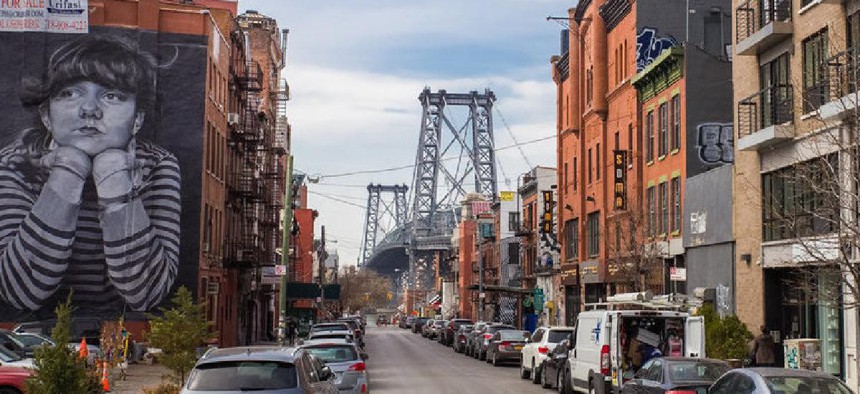For someone who clearly knows nothing about Brooklyn, New York magazine’s Andrew Sullivan sure likes to throw shade at New York City’s largest borough. Or, perhaps we should say “Brooklyn,” as the place Sullivan inveighs against does not exist other than as a figment of his imagination.
In a curious, rambling screed against contemporary feminism published Friday, Sullivan referred to Brooklyn three times. Nothing in his blog post actually had anything to do with the borough or any of its 2.6 million inhabitants. Rather, Sullivan uses Brooklyn as a metonym for a particularly aggressive brand of millennial political correctness on all matters of gender identity. He blames that phantom ideology for inciting a backlash that has made most Americans skeptical that sexism even exists and helped to elect Donald Trump. It’s a crude and inaccurate political variation on the media’s grating habit of saying “Brooklyn,” when they really mean only Brooklyn’s gentrified northwestern quadrant. Here are the quotes:
– “If most men are told that what they are deep down is, in fact, ‘problematic’ if not ‘toxic,’ they are going to get defensive, and with good reason. And they are going to react. So, by the way, are the countless women who do not see this kind of masculinity as toxic, who want men to be different, who are, in fact, deeply attracted to the core aggression of the human male, and contemptuous of the latest orthodoxy from Brooklyn.”
– “Two-thirds of Independents now suspect the sincerity of most claims of sexism. Congrats, Brooklyn.”
– “Democrats and liberals are going to have to decide if they want to ‘problematize’ half the voting population. They are going to have to figure out who they really side with: Brooklyn or much of America?”
Sullivan’s image of Brooklyn is so at odds with reality that it suggests he has probably barely set foot in the place he’s so quick to malign. Sullivan apparently thinks Brooklyn is all young, highly-educated and on the far left edge of social and cultural politics. Here are some facts about Brooklyn, courtesy of the U.S. Census Bureau, that might surprise Sullivan and even some of his readers and colleagues at New York:
– With a median household income of $50,640, Brooklyn is New York’s second-poorest borough after the Bronx. It is less affluent than the country as a whole.
– Brooklyn’s 20.6 percent of residents living in poverty is significantly higher than the national rate.
– Brooklyn is only 36 percent non-Hispanic white.
– Of Brooklynites ages 25 and older, only 34 percent have bachelor’s degrees or higher.
– A language other than English is spoken in 46 percent of Brooklyn households.
By almost any measure, Brooklyn is less elite than Sullivan’s own hometown Washington, D.C., which has a higher median household income ($72,935), higher percentage of residents with college degrees (55 percent) and lower poverty rate (18.6 percent). Brooklyn is much more representative of the United States than D.C. is – more working-class and more ethnically diverse.
Brooklyn is even more conservative than D.C. Sullivan’s snarky handwringing notwithstanding, actual Brooklyn contains plenty of cultural conservatives who might share his antipathy for the left wing of contemporary academic feminism: the Hasidim and other ultra-Orthodox Jews in Midwood, Borough Park and south Williamsburg, Sephardim in Gravesend, Italian-Americans in Bay Ridge and Dyker Heights, Russian-Americans in Brighton Beach and Irish-American cops and fireman everywhere from Windsor Terrace to Mill Basin. And plenty more of Brooklyn’s Democratic-leaning constituencies – Latinos and Asian-Americans in Sunset Park and Kensington, African-Americans and Caribbean-Americans in Brownsville, East New York, Canarsie and East Flatbush – may have a range of views on social issues. Does Sullivan not know, or merely not care, that all these people live in Brooklyn?
In an unrelated item within the same post, Sullivan squeezes in yet another caricature of Brooklyn’s politics. Pathetically celebrating The New York Times’ publication of a guide to spending a weekend in Sullivan’s beloved D.C. – for someone who so despises New York, Sullivan desperately craves New York’s approval – he enthuses that the capital city has greater political diversity. “There’s also a wider variety of views in D.C., in part because the city has to sustain a lot of Republicans as well as Democrats,” Sullivan writes. “So it doesn’t have quite the stifling left-liberal bubble of Manhattan, or the oppressive feel of the People’s Republic of Woke across the river in Brooklyn.”
One wonders what terrible oppression happened to Sullivan the one time he went to Williamsburg, but he should know better than to make factual claims that can be easily disproved. Brooklyn, like New York City as a whole, had a much higher share of Republican voters in the 2016 presidential election (18 percent and 19 percent, respectively) than D.C. (4.1 percent).
Even the politics of Brooklyn-inhabiting educated millennial readers – typical New York magazine readers, one might say – are not necessarily what Sullivan portrays. Sullivan dismisses Brooklyn as in thrall to identity-obsessed, easily-offended Woke politics, but many white-collar liberal Brooklynites are more focused on issues like economic justice – and they are as eager as Sullivan to win back working-class white voters.
What’s especially rich about Sullivan’s hackish misrepresentation of Brooklyn is that on the very same item about D.C. he complains that the author of the Times piece falsely maligns Washington as having recently shaken off “the starchy, insular appearance of a white male fiefdom,” noting that D.C. was for a long time majority African-American.
He is right to complain: The Times used a broad image of D.C. – held by outsiders and based solely on its most affluent, socially elite and transient residents – and treated it as the actual embodiment of the place. And that is precisely what Sullivan did to Brooklyn. A magazine called New York ought to know its own city better.


